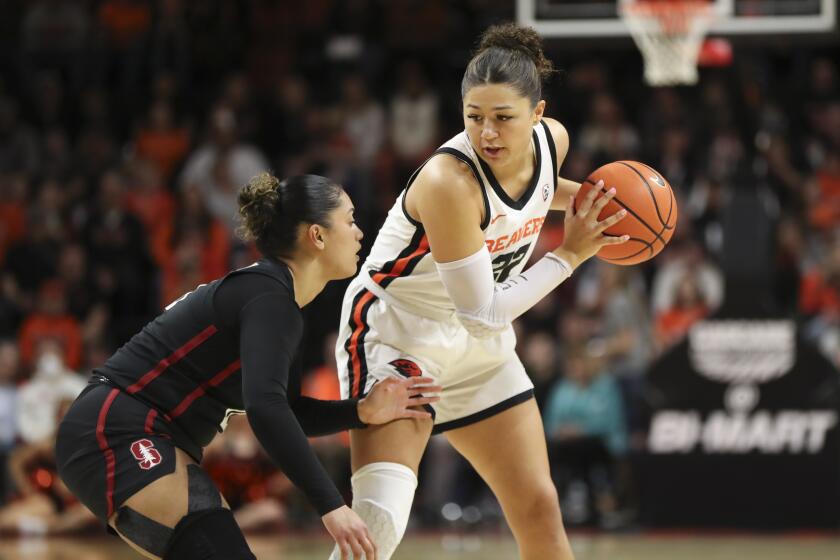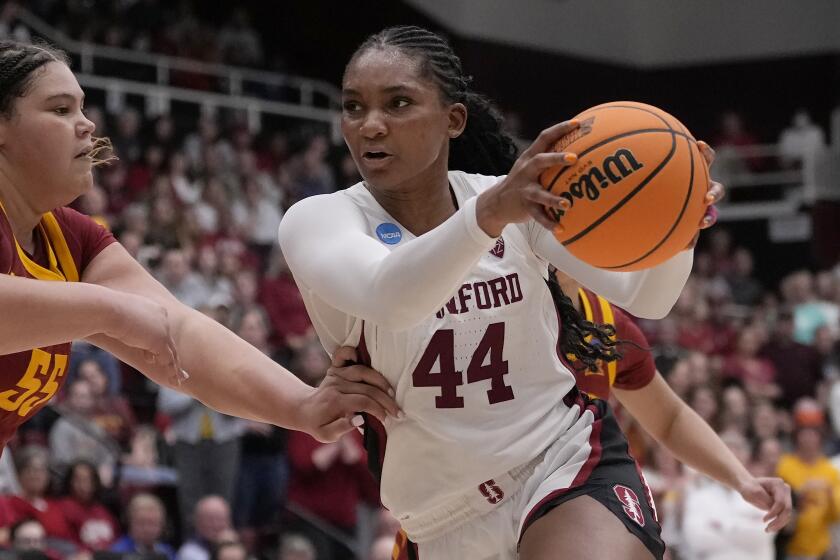Success Yields Few Startling Admissions
Like other tour guides who show prospective students around the USC campus, at some point Meghan Martineau feels compelled to mention the football team.
The Trojans have won 34 consecutive games, spanning two national championships with a chance for a third against Texas in the Rose Bowl on Wednesday. Martineau describes the buzz around campus on Saturday mornings, a sense of pride among the student body.
Then, she asks her guests if they would like to visit Heritage Hall to view the team’s trophies from seasons past.
“Sometimes no one is interested,” said Martineau, a USC senior who works part-time as a guide. “They’re way more concerned about what units they can transfer in and where they’ll be living in the dorms.”
There is a popular theory that winning teams benefit their universities in ways that go beyond ticket sales and money for new stadiums. It makes intuitive sense: A team that plays on national television might serve as a marketing tool, boosting applications. Excited alumni might be more willing to donate, even to academic programs.
But Martineau’s experience coincides with observations by USC administrators and nationwide research, all of it questioning the link between athletic success and the university at large.
At USC, where applications and academic fundraising have been on the rise for a decade, President Steven Sample said, “It’s hard to untangle the factors here.
“The positive name recognition has been very helpful. But I wouldn’t say it has been the main factor.”
Any discussion of this issue must begin with a 1984 football game in which Boston College quarterback Doug Flutie completed a Hail Mary pass to upset Miami. The touchdown was shown over and over on the news.
Applications to the university rose significantly the following year and “the Flutie factor” became a part of the higher education vernacular.
There have been other examples. Applications to Georgetown in Washington spiked during the mid-1980s, when the basketball team was highly successful. The same thing happened at Northwestern as the historically woeful football team made a run to the 1996 Rose Bowl.
“Once the Cinderella season got started, the applications poured in,” a university administrator told The Times a few years later.
When teams play on television, it is common practice to show halftime commercials that highlight each school. During the Insight Bowl on Tuesday night, ESPN also ran a collegiate “Tale of the Tape” graphic with tidbits of information about the campuses.
In this way, universities get free advertising. But experts say the brief television spots go only so far.
In the case of Boston College, the rise in applications followed a more involved campaign to attract new students by, among other things, improving academic facilities and dorms. And the university experienced another spike -- after the football team finished with a 4-7 record in 1998.
A 2000 survey by the Art & Science Group, a Baltimore consulting firm that specializes in higher education, suggested that only 10-15% of college-bound high school seniors were influenced by athletics.
Internships, student clubs and even intramural sports ranked higher among the priorities of the 500 students surveyed. Those who said they were swayed by a winning team also reported lower test scores and lower household incomes, the study found.
Any purported connection between admissions and success on the playing field “is little more than a myth -- another fiction in a long string of rationalizations used to justify the emphasis on intercollegiate athletics that is increasingly out of control,” the survey concluded.
The NCAA -- which governs major college sports -- has examined the issue in recent years. An April 2005 report found no evidence that schools trying to build winning teams by spending more on athletics were attracting applicant pools with higher SAT scores. Nor did any conclusive data link increased spending on football or basketball to increased alumni giving.
In a separate 2004 paper, the independent Knight Foundation Commission on Intercollegiate Athletics cited instances in which donations rose as football teams reached bowl games and basketball teams qualified for the NCAA tournament.
However, Cornell economist Robert H. Frank, the paper’s author, stated: “The empirical literature seems to say that if the overall net effect of athletic success on alumni giving is positive, it is likely to be small.”
At USC, a steady increase in applications began years before the football team started its winning streak, administrators said.
L. Katharine Harrington, the dean of admission and financial aid, would like to think more high school seniors are applying because of programs that put tenured professors in undergraduate classrooms and offer help in getting internships.
Harrington has a similar explanation for the rise in the average SAT score of incoming freshmen, which has gone from 1,095 in 1993 to 1,364 this year.
“We’ve been very intentional about this,” she said. “We have targeted geo-market strategies. We seek to go where the best [high school] students are.”
Still, a winning football team has brought record-setting donations to the athletic department, including a $35-million gift to help build an arena. Sample looks at this trend and wonders if it might eventually spill over to the academic side.
“A young donor may start out with $100 a year to the athletic department,” the university president said. “With a very exciting season, he may go to $1,000 a season and, later, to $10,000 and $100,000. Then his next gift could be to some academic program.”
Sample says this “without any scientific data in front of me.”
If nothing else, there is a consensus -- even among skeptics -- that winning teams bring intangible benefits. As Harrington explained, “It makes for a very exciting campus.”
And when Martineau, a music-industry major, gives her tours, she tells prospective students that it is hard not to get swept up in football season.
“We talk about it in a community sense,” she said. “There’s a lot of school spirit. You know what everyone is going to be doing on Saturdays.”
Go beyond the scoreboard
Get the latest on L.A.'s teams in the daily Sports Report newsletter.
You may occasionally receive promotional content from the Los Angeles Times.




